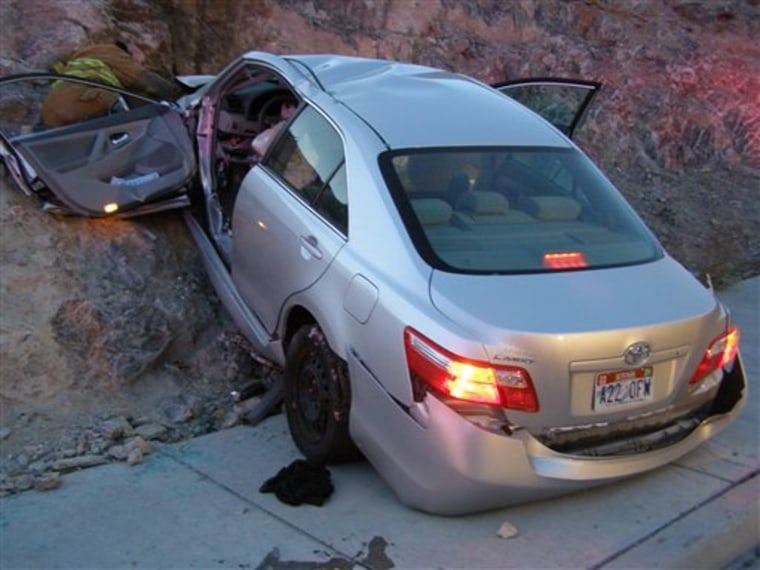The deadly crash of a Toyota Camry in western Utah is being blamed on a sticky gas pedal, the same problem that led the world's largest automaker to recall the car for repairs early this year.
The 2008 Camry slammed into a rock wall near the Nevada border on Nov. 5, killing the driver and a passenger. The vehicle was the subject of three recalls, most recently for an accelerator that can get stuck in the open position.
The crash raised questions about Toyota Motor Corp.'s system for repairing flaws in its vehicles. Safety advocates note that the government has received dozens of customer complaints about problems continuing even after a repair.
"To think that Toyota has solved the problem with these recalls, I think the complaints show something different," said Sean Kane, founder of Safety Research & Strategies Inc., a Massachusetts-based firm that has studied Toyota's recalls.
In the past year, Toyota has recalled millions of vehicles because of floor mats that can snag gas pedals or accelerators that can sometimes stick. Hundreds of lawsuits were filed against Toyota after it began issuing the recalls.
Brian Lyons, a Toyota spokesman, said the automaker was assisting the Utah Highway Patrol with its investigation. The automaker said it was too early to draw any conclusions about the cause of the crash.
Toyota engineers typically help law enforcement agencies review vehicle black boxes, which track what's happening in a car in the moments before and after a crash.
In the Utah crash, tire skid marks showed that the Camry's driver, Paul Vanalfen, 66, tried to stop the vehicle as it exited Interstate 80, police said. The car went through a stop sign at the bottom of the ramp and through an intersection before hitting the wall.
The passenger — his son's fiancee, Charlene Lloyd, 38 — also died. Vanalfen's wife and son were injured.
"Based on statements from witnesses and statements from those that survived the crash inside the car, (the investigator is) led to believe that the pedal was stuck," Utah Highway Patrol Trooper Todd Johnson said.
The Camry's brakes appeared to be in working order, he said.
The 2008 Camry was subject to recalls focusing on all-weather floor mats interfering with accelerator pedals, unsecured mats entrapping the gas pedal and accelerators getting stuck.
The first recall, involving 55,000 vehicles, came in September 2007. It was prompted by some owners stacking all-weather plastic floor mats on top of carpet floor mats, causing interference with the pedal. Mats were made available to owners.
The second recall, in October 2009, brought wide attention to the safety of Toyota's vehicles.
Toyota said 4.4 million vehicles were recalled because the unsecured mats could cause the gas pedal to get stuck in the wide-open position. It was later expanded to about 5.4 million vehicles.
To fix the problem, owners were told to remove the floor mat and dealers replaced the gas pedal and in some cases adjusted the surface of the floor to increase the space between the pedal and the floor.
Through early November, Toyota said about 3 million vehicles covered by the recall had been fixed. That included more than 80 percent of the Toyota Camry, Avalon and Lexus ES350 models involved.
Utah investigators did not immediately know whether Vanalfen complied with the first two recalls.
The third notice covering Vanalfen's Camry was announced in January and affected 2.3 million vehicles with accelerators that could stick and be slow to return to the idle position, leaving the throttle open.
Toyota said through early November it had inspected and repaired 1.85 million vehicles. Dealers installed a steel reinforcement bar to reduce the friction inside the pedal and prevent the gas pedal from sticking.
Johnson said investigators believe Vanalfen had taken his car into the dealership to address the latest recall notice.
He said his agency had not completed its investigation and it wasn't immediately clear how long that would take.
Toyota spokesman Paul Nolasco in Tokyo said he did not have details on whether the Vanalfen Camry underwent any fixes under its recall.
Federal transportation investigators were reviewing the details of the crash and declined further comment on it.
The National Highway Traffic Safety Administration said it has received about 3,000 reports of sudden acceleration from Toyota drivers in the past decade, including 93 deaths. The government, however, has confirmed only four deaths from one crash.
Camrys from the 2007-10 model years covered by the second floor mat entrapment recall were supposed to receive a brake override system. The system was designed to cut engine power when a driver is applying both the brakes and the accelerator pedal together.
It wasn't immediately clear if the Camry in the Utah crash was equipped with the system.
Toyota has said it has aggressively responded to the safety concerns and expanded the engineering team sent out to examine cars that owners claim speeded up on their own.
Toyota said it hasn't found any electronic problem, a potential culprit raised by lawyers and safety advocates, after reviewing 4,200 vehicles in which owners alleged problems with unintended acceleration.
The government said about 70 percent of recalled vehicles get fixed 1 1/2 years after the recall is launched.
